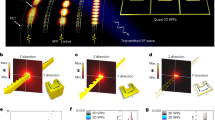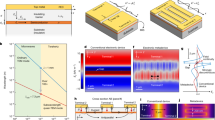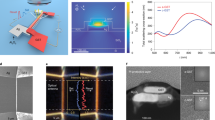Abstract
Electrically tunable metadevices can add novel functionalities to electronic and electromagnetic systems such as antennas and cloaking technologies. However, current microwave metadevices are based on materials that require sophisticated and expensive fabrication processes, and are not compatible with large-area and high-throughput deposition techniques on flexible platforms. Here we report reconfigurable microwave resonators that are electrically tuned by organic electrochemical transistors. The devices are fabricated via inkjet printing onto polyimide substrates using commercial metal nanoparticle and conducting polymer inks. By applying electrostatic gating to the polymer—a mixed ion–electron conductor—we show that the amplitude and frequency of different microwave resonant structures, including individual magnetic and electric split-ring resonators as well as a metasurface, can be modulated in the sub-5-GHz range.
This is a preview of subscription content, access via your institution
Access options
Access Nature and 54 other Nature Portfolio journals
Get Nature+, our best-value online-access subscription
$29.99 / 30 days
cancel any time
Subscribe to this journal
Receive 12 digital issues and online access to articles
$119.00 per year
only $9.92 per issue
Buy this article
- Purchase on Springer Link
- Instant access to full article PDF
Prices may be subject to local taxes which are calculated during checkout



Similar content being viewed by others
Data availability
The data that support the plots within this paper and other findings of this study are available from the corresponding author upon reasonable request.
References
Smith, D. R., Pendry, J. B. & Wiltshire, M. C. K. Metamaterials and negative refractive index. Science 305, 788–792 (2004).
Pendry, J. B., Schurig, D. & Smith, D. R. Controlling electromagnetic fields. Science 312, 1780–1782 (2006).
Zheludev, N. I. & Kivshar, Y. S. From metamaterials to metadevices. Nat. Mater. 11, 917–924 (2012).
Zhao, X., Duan, G., Li, A., Chen, C. & Zhang, X. Integrating microsystems with metamaterials towards metadevices. Microsyst. Nanoeng. 5, 5 (2019).
Tao, H. et al. Metamaterial silk composites at terahertz frequencies. Adv. Mater. 22, 3527–3531 (2010).
Salim, A. & Lim, S. Review of recent metamaterial microfluidic sensors. Sensors 18, 232 (2018).
Cui, T. J., Liu, S. & Zhang, L. Information metamaterials and metasurfaces. J. Mater. Chem. C 5, 3644–3668 (2017).
Hai, A., Spanoudaki, V. C., Bartelle, B. B. & Jasanoff, A. Wireless resonant circuits for the minimally invasive sensing of biophysical processes in magnetic resonance imaging. Nat. Biomed. Eng. 3, 69–78 (2019).
Chen, H. T. et al. Active terahertz metamaterial devices. Nature 444, 597–600 (2006).
Chen, H. T. et al. A metamaterial solid-state terahertz phase modulator. Nat. Photon. 3, 148–151 (2009).
Balci, O. et al. Electrically switchable metadevices via graphene. Sci. Adv. 4, eaao1749 (2018).
Nemati, A., Wang, Q., Hong, M. & Teng, J. Tunable and reconfigurable metasurfaces and metadevices. Opto Electron. Adv. 1, 18000901–18000925 (2018).
He, Q., Sun, S. & Zhou, L. Tunable/reconfigurable metasurfaces: physics and applications. Research 2019, 1849272 (2019).
Fratini, S., Nikolka, M., Salleo, A., Schweicher, G. & Sirringhaus, H. Charge transport in high-mobility conjugated polymers and molecular semiconductors. Nat. Mater. 19, 491–502 (2020).
Arias, A. C., MacKenzie, J. D., McCulloch, I., Rivnay, J. & Salleo, A. Materials and applications for large area electronics: solution-based approaches. Chem. Rev. 110, 3–24 (2010).
Reynolds, J. R., Thompson, B. C. & Skotheim, T. A. Conjugated Polymers: Properties, Processing and Applications (CRC Press, 2019).
Caironi, M. & Noh, Y. Y. Large Area and Flexible Electronics (Wiley-VCH, 2015).
Inal, S., Rivnay, J., Suiu, A. O., Malliaras, G. G. & McCulloch, I. Conjugated polymers in bioelectronics. Acc. Chem. Res. 51, 1368–1376 (2018).
Rivnay, J. et al. Organic electrochemical transistors. Nat. Rev. Mater. 3, 17086 (2018).
Paulsen, B. D., Tybrandt, K., Stavrinidou, E. & Rivnay, J. Organic mixed ionic–electronic conductors. Nat. Mater. 19, 13–26 (2020).
Perinot, A., Passarella, B., Giorgio, M. & Caironi, M. Walking the route to GHz solution‐processed organic electronics: a HEROIC exploration. Adv. Funct. Mater. 30, 1907641 (2020).
Zschieschang, U. et al. Roadmap to gigahertz organic transistors. Adv. Funct. Mater. 30, 1903812 (2020).
Van De Burgt, Y., Melianas, A., Keene, S. T., Malliaras, G. & Salleo, A. Organic electronics for neuromorphic computing. Nat. Electron. 1, 386–397 (2018).
Cea, C. et al. Enhancement-mode ion-biased transistor as a comprehensive interface and real-time processing unit for in vivo electrophysiology. Nat. Mater. 19, 679–686 (2020).
Giovannitti, A. et al. n-type organic electrochemical transistors with stability in water. Nat. Commun. 7, 13066 (2016).
Spyropoulos, G. D., Gelinas, J. N. & Khodagholy, D. Internal ion-gated organic electrochemical transistor: a building block for integrated bioelectronics. Sci. Adv. 5, eaau7378 (2019).
Melianas, A. et al. Temperature-resilient solid-state organic artificial synapses for neuromorphic computing. Sci. Adv. 6, eabb2958 (2020).
Pitsalidis, C. et al. Transistor in a tube: a route to three-dimensional bioelectronics. Sci. Adv. 4, eaat4253 (2018).
Marqués, R., Mesa, F., Martel, J. & Medina, F. Comparative analysis of edge- and broadside-coupled split ring resonators for metamaterial design—theory and experiments. IEEE Trans. Antennas Propag. 51, 2572–2581 (2003).
Wang, J. et al. A tunable left-handed metamaterial based on modified broadside-coupled split-ring resonators. Prog. Electromagn. Res. Lett. 6, 35–45 (2009).
Tseng, P., Napier, B., Garbarini, L., Kaplan, D. L. & Omenetto, F. G. Functional, RF-trilayer sensors for tooth-mounted, wireless monitoring of the oral cavity and food consumption. Adv. Mater. 30, 1703257 (2018).
Ekmekci, E., Topalli, K., Akin, T. & Turhan-Sayan, G. A tunable multi-band metamaterial design using micro-split SRR structures. Opt. Express 17, 16046–16058 (2009).
Gulich, R., Köhler, M., Lunkenheimer, P. & Loidl, A. Dielectric spectroscopy on aqueous electrolytic solutions. Radiat. Environ. Biophys. 48, 107–114 (2009).
Yaghmaee, P. et al. Tunable electric-LC resonators using liquid crystal. In Proc. IEEE Antennas and Propagation Society, AP-S International Symposium (Digest) 382–383 (IEEE, 2013); https://doi.org/10.1109/APS.2013.6710852
Withayachumnankul, W., Fumeaux, C. & Abbott, D. Planar array of electric-LC resonators with broadband tunability. IEEE Antennas Wirel. Propag. Lett. 10, 577–580 (2011).
Schurig, D., Mock, J. J. & Smith, D. R. Electric-field-coupled resonators for negative permittivity metamaterials. Appl. Phys. Lett. 88, 041109 (2006).
Liu, R., Degiron, A., Mock, J. J. & Smith, D. R. Negative index material composed of electric and magnetic resonators. Appl. Phys. Lett. 90, 263504 (2007).
Yaghmazadeh, O. et al. Optimization of organic electrochemical transistors for sensor applications.J. Polym. Sci. 49, 34–39 (2011).
Andersson Ersman, P. et al. All-printed large-scale integrated circuits based on organic electrochemical transistors. Nat. Commun. 10, 5053 (2019).
Yan, F., Parrott, E. P. J., Ung, B. S. Y. & Pickwell-Macpherson, E. Solvent doping of PEDOT/PSS: effect on terahertz optoelectronic properties and utilization in terahertz devices. J. Phys. Chem. C 119, 6813–6818 (2015).
Du, Y. et al. Dielectric properties of DMSO-doped-PEDOT:PSS at THz frequencies. Phys. Status Solidi 255, 1700547 (2018).
Ohayon, D. et al. Biofuel powered glucose detection in bodily fluids with an n-type conjugated polymer. Nat. Mater. 19, 456–463 (2020).
Acknowledgements
The authors thank T. J. Quill for helping with the preparation of the ion gel, S. Taheri, B. Murmann and the System Prototyping Facility (Stanford University) for the free-space characterization set-up, as well as FLEXcon for the polyimide substrates. The authors thank B. Napier, N. Ostrovsky-Snider, J. Roshko, S. T. Keene for useful discussions, as well as A. Salleo for support in finalizing the experimental activities. The authors gratefully acknowledge support from the Office of Naval Research (grant no. N-00014-19-12399).
Author information
Authors and Affiliations
Contributions
G.E.B. designed, fabricated and characterized the devices, and performed the simulations and data analysis. F.G.O. analysed the data, and supervised and coordinated the research activities. Both authors wrote the manuscript.
Corresponding author
Ethics declarations
Competing interests
Tufts University has filed an invention disclosure based on the technology presented in this paper.
Additional information
Peer review information Nature Electronics thanks Jonathan Rivnay and the other, anonymous, reviewer(s) for their contribution to the peer review of this work.
Publisher’s note Springer Nature remains neutral with regard to jurisdictional claims in published maps and institutional affiliations.
Extended data
Extended Data Fig. 1 Equivalent circuit of a DBSRR.
The equivalent circuit of a DBSRR consists of a LC resonant circuit. According to Ref. 29, in this model the inductance L is approximated by the self-inductance of the two SRRs and R represents the dissipative losses due to the finite conductivity of the rings. The equivalent capacitance C results from the combination of the two split capacitances Cs with the mutual capacitance C0, established between the top and bottom SRRs.
Extended Data Fig. 2 Characterization setup.
a, Schematic representation of the characterization setup used for the amplitude and frequency modulated DBSRR. b, Photograph of the primary coils. c, Photograph of the DBSRR aligned to the primary coil, with the probes used for biasing the device (scale bar: 10 mm). d, Photograph of the inset feed microstrip-patch antenna used to characterize the individual tuneable ELC (see Extended Data Fig. 8g). e, Return loss of the inset feed microstrip-patch antenna, resonant at 2.7 and 5.2 GHz.
Extended Data Fig. 3 DBSRR geometry.
The geometry for the bottom and top SRRs of both amplitude and frequency modulated devices is shown. The table reports the geometrical features of the devices in terms of W, the lateral size of the square SRRs.
Extended Data Fig. 4 Amplitude modulation.
Amplitude modulation of 8 and 12 mm DBSRRs.
Extended Data Fig. 5 Frequency modulation.
Frequency modulation of 8 and 12 mm DBSRRs.
Extended Data Fig. 6 Frequency modulated DBSRRs – simulations.
a,b The frequency shifts of the devices were simulated by considering a standard DBSRR structure (a) and one modified with the two additional gaps (b). In both scenarios, magnetic and electric boundary conditions were established along the xy and yz planes respectively, with the incident plane wave propagating normal to the xz plane. c, The simulated and experimental resonance frequency shifts were calculated for devices of 8, 10 and 12 mm in lateral size: brown dots represent simulations run with devices of nominal size and geometry. Such simulation provides values that deviate from experimental frequency shifts (green dots), which we ascribe to minor differences in real device geometry, such as minor differences in size, top/bottom SRR alignment, substrate thickness variability (±2 μm) and edge effects. As demonstration, we calculated the resonance frequency shifts for DBSRRs with reduced lateral size (95% of nominal value, orange dots), which are more in agreement with experimental data. d-f, Simulated (dashed) and measured (solid) S11 plots for devices of different lateral size (reduced geometry was used for simulated data): brown curves for standard DBSRR structures, and green curves for modified ones.
Extended Data Fig. 7 Cycling stability.
a,b Voltage dependence of the S11 parameter (at resonance) for two tunable DBSRRs (10 mm) gated by a liquid electrolyte (a) and an ion-gel (b) respectively, cycled multiple times. c,d The same devices cycled between 200 and 600 mV (brown and green dots respectively) for 20 times: the liquid electrolyte was changed after the 10th cycle. e, Cycling stability of two separate OECT devices gated by means of a liquid electrolyte (brown curve) and an ion-gel (green curve), with transistor channel geometry equivalent to that used within the DBSRRs (10 mm). The test was performed by applying a constant lateral drain-source bias (Vds = −0.1 V) while Vgate varied between 0.2 and 0.6 V, at intervals of 5 s, for a total of 100 cycles. During the test, the drain-source current was continuously monitored and used to calculate the channel conductance Gch. f, Transfer curves of the two OECTs, before (solid curve) and after the cycling stress test (dashed curve).
Extended Data Fig. 8 Alternative geometries – Asymmetric, dual-band devices.
a, Modified frequency tuneable device: in this configuration, an additional gap is introduced on the side of the top SRR. b, S11 plots of the device at different gating voltages: due to the asymmetry of the conductive pattern, the frequency modulation is associated to a decrease in amplitude. c, Voltage dependence of the amplitude (green curve) and of the resonance frequency (brown curve). d, Dual-band DBSRR: two concentric DBSRR are patterned on the substrate, the outer one being the modulated device. e, S11 plots of the device at different gating voltages: while the Low-Frequency (LF) resonance amplitude associated to the outer device is modulated, the High-Frequency one (HF) is stable. f, Voltage dependence of the amplitude modulation, reported as the ratio between the LF and the HF amplitudes for three consecutive cycles. g, Schematic representation of a tuneable electric inductive-capacitive resonator. h, Return losses (S11 plots) of a tuneable ELC, monitored with an inset feed microstrip patch antenna, showing amplitude modulation exceeding 25 dB (dashed curve represents a dry device). i, Voltage dependence of the resonance amplitude.
Extended Data Fig. 9 Alternative channel geometries – extended split and modified channel area.
a, Modified geometry of the DBSRR, presenting two protruded fingers extending from the split (approx. 2 cm). b, Photograph of the device during characterization. c,d S11 plots of the device operating in deionized water (b) and DPBS (c). e, Voltage dependence of the amplitude, for three consecutive cycles. f, Plot of the S11 phase at different gating voltages (brown to green). g, Schematic representation of three different channel geometries: options B and C, with reduced split length, display a reduced modulation compared to the standard split (h).
Extended Data Fig. 10 ELC metasurface - geometry and simulations.
a, The geometry of the ELC unit cell is shown (PEDOT:PSS areas in light blue). b, The table reports the relevant dimensions for the ELC unit cell of the metasurface (14 × 11.5 mm2). c, The ELC structure used in this work was simulated by applying magnetic and electric boundary conditions along the transverse planes (yz and xz respectively), with a normally incident plane wave. d, The S11 plot was calculated for two different configurations: with OECT devices OFF (green) and ON (brown) respectively. The OECT in the ON state was simulated as a conductive layer bridging the two sides of the split (top inset).
Supplementary information
Supplementary Information
Supplementary Table 1 Benchmarking analysis.
Rights and permissions
About this article
Cite this article
Bonacchini, G.E., Omenetto, F.G. Reconfigurable microwave metadevices based on organic electrochemical transistors. Nat Electron 4, 424–428 (2021). https://doi.org/10.1038/s41928-021-00590-0
Received:
Accepted:
Published:
Issue Date:
DOI: https://doi.org/10.1038/s41928-021-00590-0



